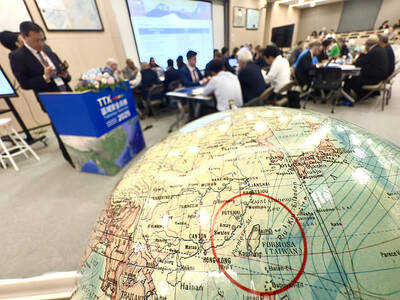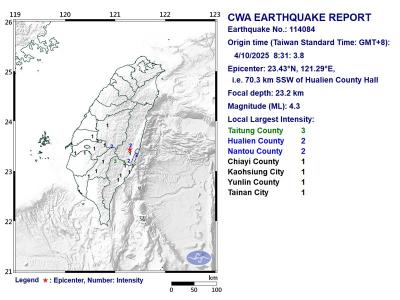An inscription found in the tomb of Zhu Yihai (朱以海, 1618-1662), Prince of Lu during the Ming Dynasty, is on display at the Historical Folk Museum in Kinmen County.
The inscription, which was carved into a tombstone and buried with Zhu shortly after his death in the county in 1662, was discovered during construction work in 1959 and transferred to the National Museum of History in Taipei.
The 726-character inscription records Zhu’s visits with civilian officials and militia generals in China’s Zhejiang, Fujian and Guangdong provinces after the fall of the Ming Dynasty in 1644.
Zhu and three other princes led resistance movements — called the Southern Ming — against the military of the Manchu Qing Dynasty.
At the official opening of the exhibition on Friday last week, former National Museum of History director Chang Yui-tan (張譽騰) said he is glad to see the inscription returned to Kinmen for the exhibition and hopes the county would become a center for Southern Ming studies.
Since the inscription is to return to Taipei after the exhibition, a 3D-printed replica was made and presented to county government, National Museum of History director Chen Teng-chin (陳登欽) said.
The exhibition is significant as culture from both Minnan (Southern Fujian Province) and the Southern Ming enable the county to act as a bridge between Taiwan and China, County Secretary-General Lin De-gong (林德恭) said.
The inscription also says that Zhu died of asthma on Kinmen and not at sea on the orders of Koxinga (Cheng Cheng-kung, 鄭成功) as recorded in the dynastic history of the Ming, indicating that Zhu had died about six months after Koxinga’s death.
The exhibition is part of activities to mark the 400th anniversary of Zhu’s birth and is to run until Aug. 30.

DEFENSE: The National Security Bureau promised to expand communication and intelligence cooperation with global partners and enhance its strategic analytical skills China has not only increased military exercises and “gray zone” tactics against Taiwan this year, but also continues to recruit military personnel for espionage, the National Security Bureau (NSB) said yesterday in a report to the Legislative Yuan. The bureau submitted the report ahead of NSB Director-General Tsai Ming-yen’s (蔡明彥) appearance before the Foreign and National Defense Committee today. Last year, the Chinese People’s Liberation Army (PLA) conducted “Joint Sword-2024A and B” military exercises targeting Taiwan and carried out 40 combat readiness patrols, the bureau said. In addition, Chinese military aircraft entered Taiwan’s airspace 3,070 times last year, up about

A magnitude 4.3 earthquake struck eastern Taiwan's Hualien County at 8:31am today, according to the Central Weather Administration (CWA). The epicenter of the temblor was located in Hualien County, about 70.3 kilometers south southwest of Hualien County Hall, at a depth of 23.2km, according to the administration. There were no immediate reports of damage resulting from the quake. The earthquake's intensity, which gauges the actual effect of a temblor, was highest in Taitung County, where it measured 3 on Taiwan's 7-tier intensity scale. The quake also measured an intensity of 2 in Hualien and Nantou counties, the CWA said.

The Overseas Community Affairs Council (OCAC) yesterday announced a fundraising campaign to support survivors of the magnitude 7.7 earthquake that struck Myanmar on March 28, with two prayer events scheduled in Taipei and Taichung later this week. “While initial rescue operations have concluded [in Myanmar], many survivors are now facing increasingly difficult living conditions,” OCAC Minister Hsu Chia-ching (徐佳青) told a news conference in Taipei. The fundraising campaign, which runs through May 31, is focused on supporting the reconstruction of damaged overseas compatriot schools, assisting students from Myanmar in Taiwan, and providing essential items, such as drinking water, food and medical supplies,

New Party Deputy Secretary-General You Chih-pin (游智彬) this morning went to the National Immigration Agency (NIA) to “turn himself in” after being notified that he had failed to provide proof of having renounced his Chinese household registration. He was one of more than 10,000 naturalized Taiwanese citizens from China who were informed by the NIA that their Taiwanese citizenship might be revoked if they fail to provide the proof in three months, people familiar with the matter said. You said he has proof that he had renounced his Chinese household registration and demanded the NIA provide proof that he still had Chinese